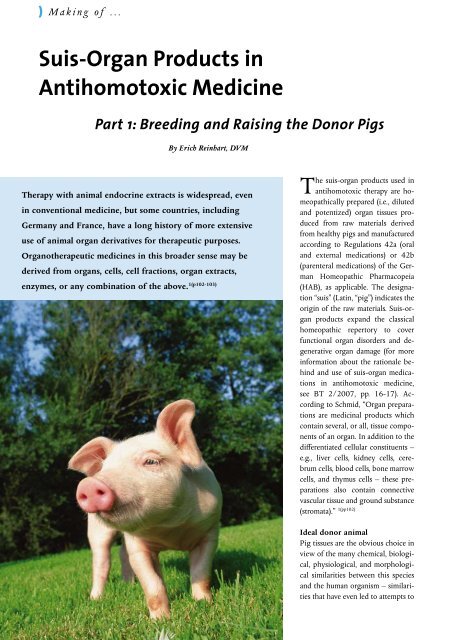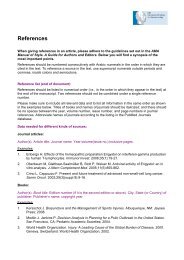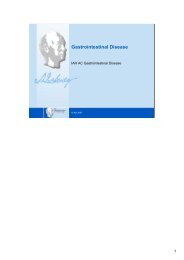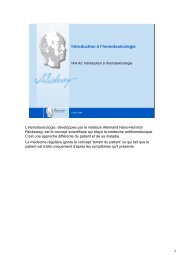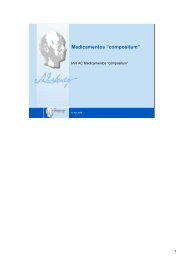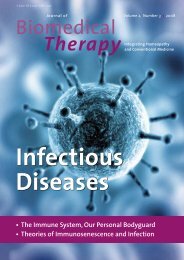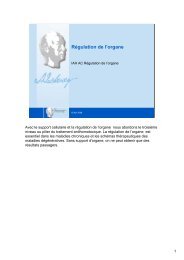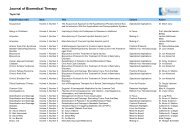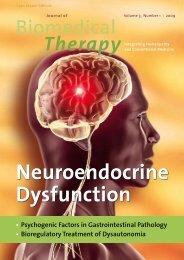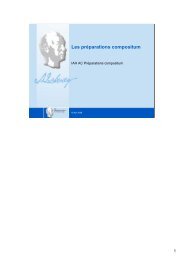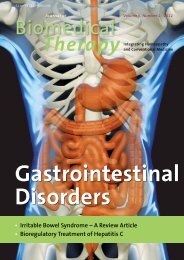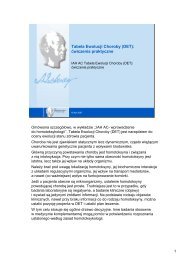Metabolic Syndrome - International Academy of Homotoxicology
Metabolic Syndrome - International Academy of Homotoxicology
Metabolic Syndrome - International Academy of Homotoxicology
You also want an ePaper? Increase the reach of your titles
YUMPU automatically turns print PDFs into web optimized ePapers that Google loves.
) Making <strong>of</strong> ...<br />
Suis-Organ Products in<br />
Antihomotoxic Medicine<br />
Part 1: Breeding and Raising the Donor Pigs<br />
By Erich Reinhart, DVM<br />
Therapy with animal endocrine extracts is widespread, even<br />
in conventional medicine, but some countries, including<br />
Germany and France, have a long history <strong>of</strong> more extensive<br />
use <strong>of</strong> animal organ derivatives for therapeutic purposes.<br />
Organotherapeutic medicines in this broader sense may be<br />
derived from organs, cells, cell fractions, organ extracts,<br />
enzymes, or any combination <strong>of</strong> the above. 1(p102-103)<br />
) 24<br />
The suis-organ products used in<br />
antihomotoxic therapy are homeopathically<br />
prepared (i.e., diluted<br />
and potentized) organ tissues produced<br />
from raw materials derived<br />
from healthy pigs and manufactured<br />
according to Regulations 42a (oral<br />
and external medications) or 42b<br />
(parenteral medications) <strong>of</strong> the German<br />
Homeopathic Pharmacopeia<br />
(HAB), as applicable. The designation<br />
“suis” (Latin, “pig”) indicates the<br />
origin <strong>of</strong> the raw materials. Suis-organ<br />
products expand the classical<br />
homeopathic repertory to cover<br />
functional organ disorders and degenerative<br />
organ damage (for more<br />
information about the rationale behind<br />
and use <strong>of</strong> suis-organ medications<br />
in antihomotoxic medicine,<br />
see BT 2/2007, pp. 16-17). According<br />
to Schmid, “Organ preparations<br />
are medicinal products which<br />
contain several, or all, tissue components<br />
<strong>of</strong> an organ. In addition to the<br />
differentiated cellular constituents –<br />
e.g., liver cells, kidney cells, cerebrum<br />
cells, blood cells, bone marrow<br />
cells, and thymus cells – these preparations<br />
also contain connective<br />
vascular tissue and ground substance<br />
(stromata).” 1(pp102)<br />
Ideal donor animal<br />
Pig tissues are the obvious choice in<br />
view <strong>of</strong> the many chemical, biological,<br />
physiological, and morphological<br />
similarities between this species<br />
and the human organism – similarities<br />
that have even led to attempts to<br />
Journal <strong>of</strong> Biomedical Therapy 2008 ) Vol. 2, No. 1


